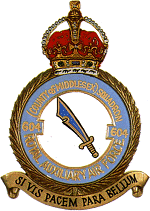Born in the aftermath of the First World War and taking its title from the County of Middlesex where it was raised and where many of its members were recruited, No.604 Squadron of the Auxiliary Air Force was formed at Hendon on the 17th March 1930 as a light-bomber unit. In its twenty-seven years of service the Squadron served as a day and night-fighter unit within Fighter Command, flying such types as the Hawker Demon, Bristol Blenheim, Bristol Beaufighter, the superlative de Havilland Mosquito, the Supermarine Spitfire and the de Havilland Vampire and Gloster Meteor jet-fighters. The Squadron was one of the first to be trained for night-fighting and one of only six who pioneered the introduction airborne radar prior to the Winter Blitz of 1940/41, during which it established its reputation as one of the RAF’s principal night-fighter squadrons. By the war’s end in May 1945, the Squadron’s score stood at 132 enemy aircraft confirmed as ‘destroyed’, mostly by night, and had made a number of its pilots and radar operators, such as ‘Cats-eyes Cunningham’ and ‘Jimmy Rawnsley’, household names.
Three of its former officers reached Air Rank and many received awards and decorations for their work with the Squadron. 604 was reformed after the war as a day-fighter unit, before moving its headquarters from Hendon to North Weald, Essex, in 1949, where it remained until disbanded in 1957. The Squadron was mobilised in the defence of the UK on three occasions; the Munich Crisis of 1938, the Second World War in 1939 and the Korean War in 1951 and was awarded the Esher Trophy for Auxiliary efficiency on three occasions. Overall, the Squadron and its spirit reflected the Auxiliaries pride of place in the RAF and in particular their defence of the UK, which is reflected in its motto: Si vis pacem, para bellum – ‘If you want peace, prepare for war’.
Ian White has graciously given permission for us to host a copy of his book on the history of 604 Squadron here: If You Want Peace, Prepare for War
Please also see our page: The History of the Royal Auxiliary Air Force

